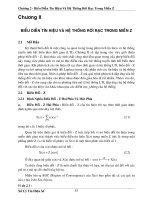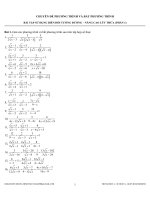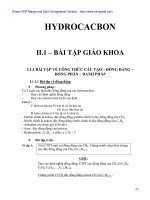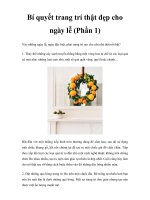Energy Management Handbook for Homeowners phần 1 pptx
Bạn đang xem bản rút gọn của tài liệu. Xem và tải ngay bản đầy đủ của tài liệu tại đây (168.35 KB, 11 trang )
Energize Your Home!
Windows
south exposure
and double-
pane with
low-E coating
(provide proper
overhang)
Wall insulation
Soffit vents with
ridge vents
Mechanical
equipment
and other
appliances
with low
operating
costs and
high
efficiencies
Ceiling
insulation
Floor or
crawl
space
insulation
Pipes and ducts
insulated in
unconditioned
space
Caulking
and sealing
to reduce
air leakage
Exterior
insulated
doors
Fluorescent
or compact
fluorescent
lighting where
suitable
Water
conservation
Energy Management
Handbook for Homeowners
Missouri Department of Natural Resources
Energy Center
P.O. Box 176, Jefferson City, MO 65102-0176
(573) 751-3443 1-800-361-4827
/>
Basic Energy Concepts 1
Heat Loss
Indoor Humidity
Weather
Air Changes 2
Infiltration Pie
Infiltration Ratings
New-Home Construction 3
Caulk/Weatherstrip 4-5
Where to caulk
Types of caulk
Air Conditioning
Efficiency 6
Window Unit vs. Central Unit
Sizing
Dehumidification 7
Placement and Maintenance
Operating Hints
Appliances 8
Life-Cycle Costing
EnergyGuide Labels
Selecting a Refrigerator 10
Selecting a Washer and Dryer
Selecting a Dishwasher 11
Appliance and Equipment
Cost of Operation 12-13-14
Heating 15
Natural Gas
Forced Air
Hydronic Systems
Combustion Air 16
Replacement Systems
Electric Heating 17
Heat Pumps
Ducts 18
Options 19
Space Heaters 20
Fireplaces and Gas Logs
Insulation Basics 21
R-Value
Recommended R-Values
Where to Insulate
Insulation, Do-It-Yourself 22
Safety
Vapor Barriers
Insulation, Attic 23
Preparation
Attic Types
Insulation, Crawl Space and Floors 24
R-Values, Various Materials 25
Insulation, Walls 26
Basement
Below Grade
Landscaping 27
Xeriscape Gardening
Lighting 28
Incandescent
Fluorescent
Outdoor Lighting
Lighting Efficiency
Moisture 29
How Moisture Acts
Window Condensation
Reducing Excess Humidity 30
New Construction
Ventilation 31
Attic
Crawl Space
Water Heaters 32
Efficiency
Types
Water-Saving Hints
How to Insulate Water Heaters 33
Water Usage 34
Indoor Water Usage
Lawn Irrigation
Other Outdoor Usage
Windows 35
Glazing Options
Storm Windows
Table of Contents
Missouri Department of Natural Resources
Energy Center
Making your home as energy-efficient as possible is only a part of the process of achieving a more comfortable and
less expensive home to operate. Your family’s habits and the weather are important in determining energy usage.
This booklet is designed to help you implement retrofit measures as well as evaluate your family’s habits in how they
use energy and water.
Temperature control is the largest use of energy in a residence. Heat flow always goes from warm areas (inside
homes in winter) to cooler ones. This flow of heat can be slowed by something such as insulation that will resist rapid
airflow movement.
Most homes are heated with gas and/or electricity, but all heat is measured in British thermal units (Btu). Btus are
very small (about the heat energy of one wooden kitchen match); therefore, over the period of a year, millions of Btus
are consumed to heat water or living space.
Heat Loss
A typical home loses heat by a combination of three basic heat-transfer processes:
1. CONDUCTION through materials and substances.
2. CONVECTION or transference of heat because of differences in density. This is what people mean when they
say heat rises. Actually, warm air (or less dense air) rises. Heat is lost in all directions to cooler areas. Convection
heat losses can cause infiltration.
3. RADIATION of heat occurs when heat flows from warm surfaces to cool surfaces independent of the medium
between them (such as a warm roof to the clear night sky, or a window surface to the outside air).
Insulation will slow heat loss. Air is a very poor conductor of heat; that’s why it is a good insulator. When air pockets
are trapped (inside insulation or between panes of glass), they retard the flow of heat. It’s not the substance itself (glass
fiber, cellulose, rockwool or foam insulation) that slows heat loss, but the trapped pockets of air that are in or between
these materials.
Resistance (R) to heat flow is measured in how many hours it takes one Btu to go through one square foot of a mate-
rial that is one inch thick and experiencing a one-degree temperature difference. A window that has an R-value of 2
loses heat ten times faster than a wall with an R-value of 20.
When you are air conditioning your home, the reverse heat flow occurs from outside to inside the house. Insulation
slows that heat flow also.
Indoor Humidity
Relative humidity is an important comfort factor. A higher relative humidity in winter will make your home feel warmer,
and a lower summer humidity will let you feel cooler at moderate temperatures. Savings in energy result from turning the
thermostat to a lower winter setting or a higher summer setting.
Weather
The weather – temperature, relative humidity, wind, cloud cover and sunshine – affect the energy used in maintaining
home comfort. Most space heating begins at 65°Fahrenheit. As the outdoor temperature falls below this base, the space
heating load increases in proportion to the difference between the two temperatures. This relationship between load and
temperature led to the engineering concept of the heating degree-day, or heating degree-hour as an index of the intensi-
ty and duration of cold weather. It is defined as the difference between the average temperature for a 24-hour time peri-
od and the base temperature of 65°F.
The degree-hour concept is somewhat more accurate during periods of “marginal” heating (or cooling) demand.
Cooling degree-hours are computed using both an outside temperature and relative humidity. These are shown on
your summer utility bill.
Basic Energy Concepts
2
Ratings Per Hour Air Changes Comments
Poor 1 to 2 Very leaky house with obvious visible cracks, no weatherstripping or
or greater caulking visible, no fireplace damper, windy site.
Fair 1.0 Some attention has been placed on controlling air leakage. Some visi-
ble weatherstripping and/or caulking. Fireplace has operable damper.
Average 0.85 Carefully weatherstripped and caulked, also has sealed double-pane
windows. Molding at base of wall and the sill plate are caulked, as well
as window and door frames. Wall outlets are sealed or gasketed.
Fireplace is sealed, or air-tight wood-burning stove is used to control air
leaking up the stack.
Good 0.65 Above, plus wall and attic vapor barriers. Double-door entry porch
reduces air losses when door is opened. Combustion heating devices
use outside air, and, where applicable, stack dampers.
Very 0.5 or less Above, but vapor barrier is continuous (all penetrations sealed, barrier
Efficient is overlapped, taped and caulked). Because of possible problems with
indoor air-pollution buildup in low infiltration houses, mechanical ventila-
tion, in the form of an efficient air-to-air heat exchanger, should be
installed.
Depending on the size and type of home construction, about one-fourth of heating costs are attributable to heating
infiltration air (uncontrolled air leakage) in residences.
Air Changes
TYPICAL AIR LEAKAGE IN
THE HOME
This chart indicates typical infiltra-
tion in homes. The areas where
heat is lost in the winter and gained
in the summer (due to free air flow
openings) are shown in the pie.
3
Air Changes
New-Home Construction
In most homes, the air inside is replaced about once every two hours, which adds up to about 25 percent of the total
heating load. Installing an airtight vapor barrier at the time of construction, adding insulation, sealing doors and windows
with weatherstripping, and caulking will reduce the incoming flow of air, thereby reducing the amount of energy required
to heat the air.
A disconcerting side effect of airtight, energy-efficient homes is indoor air pollution. Unwholesome gases, small parti-
cles of matter, offensive odors, and moisture can be trapped inside your home. This may lead to discomfort and even
harmful health effects.
Most consumers do not realize that invisible gases are found in the home. For example, formaldehyde is used as a
bonding agent in some foam insulation. Carbon dioxide is a by-product of breathing. Carbon dioxide, nitrogen oxides
and other compounds are products of combustion. These gases, along with carbon monoxide, can accumulate.
One way to reduce the heat loss but preserve air quality is to use an air-to-air heat exchanger to transfer the heat
from the outgoing stale, warm air to the incoming cold air.
For new home construction, consider the following features to reduce air leakage but preserve air quality:
1. Use weatherstripping on all exits.
2. Use sealed windows.
3. Avoid sliding patio doors.
4. Ensure a complete vapor barrier seal around the house.
5. Use a recirculating range hood for the kitchen.
6. Vent the bathroom fans into the heat exchanger.
7. Vent electric dryers into the heat exchanger.
8. If using fuel-burning furnaces, isolate the combustion air and chimney air from the house air.
9. Install an air-to-air heat exchanger.
10. Avoid recessed lighting.
4
Caulking
Caulking is an easy, energy-saving project you can do yourself. It is relatively inexpensive – and very effective. In fact,
it will usually pay for itself in energy savings within one year.
Caulk is a compound used for filling cracks, holes, crevices and joints on both the inside and outside of your home.
You will need only a few simple tools and a minimum of skill to caulk these areas. Start at the back of your house and
work toward the front so that your skill level is improved by the time you caulk places that are visible.
Try to choose a mild day to tackle this project. The outside temperature should be above 40°F for the caulk to be
applied correctly. So, plan to caulk during the spring, summer or fall for best results. Old, cracked caulk should be
removed before new is applied. Check your home repair center for a “puttying tool” that will make the job easier and pro-
vide a more professional look.
Where to Caulk
As a general rule, caulk should be applied wherever two different building materials meet on the interior or exterior of
your home. Different building materials expand and contract at various rates. Through the years, with temperature
extremes and caulk drying out, cracks develop between materials. Because these cracks allows air infiltration, the
cracks need to be caulked.
On the interior of your home, you can check for air leakage by moving your hand around the windows and doors on a
windy day. If you can feel air movement, you need to caulk and/or weatherstrip. You will probably be surprised to find
how many spots are “air leakers!”
The following are areas that should be checked:
1. Around door and window frames – inside and
out; check window pane putty.
2. Places where brick and wood siding meet.
3. Joints between the chimney and siding.
4. Between the foundation and walls.
5. Around mail chutes.
6. Around electrical and gas service entrances,
cable T.V. and phone lines, and outdoor water
faucets.
7. Where dryer vents pass through walls.
8. Cracks in bricks, siding, stucco and founda-
tion.
9. Around air conditioners.
10. Around vents and fans.
11. Wherever two different materials meet.
The material used in sealing air leaks depends on the size of the gaps and where they are located. Caulk is best for
cracks and gaps less than 1/4” wide. Expanding foam sealant is good for sealing larger cracks and holes that are pro-
tected from sunlight and moisture. Rigid foam insulation may be used for sealing very large openings such as plumbing
chases and attic hatch covers. Fiberglass insulation can also be used for sealing large holes, but it needs to be wrapped
in plastic or stuffed in plastic bags because air can leak through fiberglass.
Caulk/Weatherstrip
5
Caulk/Weatherstrip
Types of Caulking Compounds
Compound Durability Elasticity Cost Comments
Oil based 1-5 yrs Poor Low Very low elasticity.
Acrylic latex 2-10 yrs Fair to good Moderate Easy to apply, water clean-up, paintable.
Butyl rubber 5-10 yrs Fair Moderate Difficult to apply, solvent clean-up, high mois-
ture resistance.
Polyurethane 20 yrs Excellent Moderate to high Solvent clean-up, excellent elasticity,
adheres well to most surfaces.
Silicone 20 yrs+ Excellent High Paintable silicone available;
also available in clear.
Types of Weatherstripping
Visible when installed
6
Air conditioning is the second largest energy expense in most homes.
The biggest sources of unwanted summer heat in homes are windows and walls (20 to 30 percent), internal gains
from appliances and lights (15 to 25 percent), and through the roof (10 to 20 percent). In humid climates, damp outside
air leaking into the house can also increase cooling load significantly.
Efficiency
Air conditioners are rated by their efficiency levels, Seasonal Energy Efficiency Rating (SEER – commonly pro-
nounced SEAR). Ratings are shown on a yellow tag for room air conditioners and on fact sheets for central units. The
SEER is the seasonal cooling output in Btus divided by the seasonal energy input in watt hours for an average U.S. cli-
mate. It takes into account the time the unit is not running. The higher the figure the better. A unit with a SEER of 12.0
costs half as much to operate as one with a SEER of 6.0. The higher initial cost of the higher SEER unit is normally paid
back within a few years, making the more efficient equipment less expensive in the long run.
The Energy Policy Act of 1992 requires that central air conditioners manufactured after January 1994 attain at least a
SEER of 10.
The ratings refer only to operating efficiency, or cost to operate, and have nothing to do with capacity, which is rated
in Btus/hr. The Btu/hr figure indicates how much heat the air conditioner can remove from a room or house in an hour.
Sometimes a tonnage figure is used instead of Btus/hr. One ton of air conditioning is the same as 12,000 Btus/hr.
Window Unit Versus Central Unit
The buyer must make a basic decision – whether to use win-
dow units or a central system. Both have advantages.
The big plus for window units is that they allow for
zoned cooling. This can save substantial amounts of electricity
and money. Also, the actual purchase price of a window unit is
less than that of a central unit; however, you will not have the
convenience or comfort of whole-house cooling. The window
units are also noisier because the compressor is in the unit
within the living space. However, window units require no air-
ducting system as the central unit does and therefore
have no duct losses. Window units can be installed
through a wall in an enclosed space and ducted to
one or two rooms.
Central units provide whole-house air conditioning,
which may be desirable if many rooms are used on a
fairly constant basis, or it may simply be the choice of
the homeowner. Central units, with their larger size and
capacity, cost more to buy, install and run.
When replacing a condenser (outside unit), the evaporator coil (inside the house at the air handler) should also be
replaced. If this is not done, the air conditioner will not have its high efficiency.
Sizing
If you are installing or replacing a central unit, your contractor will perform the sizing calculations based on the size of
the house, window exposure and orientation, construction materials, levels of insulation, air infiltration and lifestyle. In
the past, it was standard practice to oversize the air conditioner by 10 percent to 50 percent. However, some
researchers now believe that air conditioning systems undersized by 10 percent are more efficient and more effective in
removing humidity. It is important not to oversize because such a unit, although it will cool the air, will not run for long
enough periods to reduce the indoor humidity to a comfortable level. You may feel cool and clammy rather than cool and
dry, a real comfort consideration in Missouri summers.
Air Conditioning
WINDOW OR THROUGH-THE-WALL UNIT
7
Dehumidification
Air conditioners remove moisture from the air by condensing water vapor as the air passes over cold coils. Water
vapor condenses in the same way moisture from the air condenses on a glass of ice water on a hot, humid day.
Lowering the humidity makes you feel more comfortable, but it takes more energy, which reduces the efficiency of the
air conditioner. One of the ways manufacturers have boosted air conditioner efficiency is by keeping the condenser coils
somewhat warmer, which reduces condensation. Some of the new high-efficiency air conditioners do not dehumidify as
effectively. Humidity can be reduced by including variable-speed or multi-speed blowers. Although there is no industry
standard for rating the effectiveness of removing moisture, most literature does list water removal in pints per hour,
which will help you compare one model to another. Some models have the fan speed controlled by a humidistat.
Placement and Maintenance
If possible, locate an outside compressor unit on the north side of the house. If that is not possible, try to position the
compressor where it will be shaded as much as possible. Window units may not allow you the choice.
Outside compressors should be kept clean of leaves, twigs and grass cuttings so the compressor doesn’t overheat.
Mow grass so that cuttings are discharged away from the compressor unit, or brush or spray the cuttings off the com-
pressor unit with a broom or a water hose.
Window units, if left in place during the winter, should be wrapped on the inside, and good weatherstripping should
be used to block air infiltration around the unit. If wrapped on the outside, warm moist air from inside the home can con-
dense and freeze inside the unit, possibly causing damage to the system.
For general seasonal maintenance, check the instruction manual. With central and window units, change the filters as
often as once a month during the summer. Filters are inexpensive for what they give you – clean air, free of dust and
pollen – and for what they do for the air conditioner – removing dirt or grit that wears out the moving parts prematurely,
and producing a clear air flow for more efficient operation.
Operating Hints
When setting your thermostat, don’t set the temperature colder than you want in hopes it will get cool faster – it won’t.
Experiment a bit to determine the highest temperature setting at which you can be comfortable. Try 78°F to start.
Every degree higher will save about 4 percent in operating costs.
One way to be comfortable with higher settings is to leave the fan setting on manual so it will run continuously. (The
fan costs only one-fifth as much to run as the cooling compressor.) This will also help dehumidify. You may also run
small fans.
If you have a whole-house fan (attic fan), you can save substantially on your electric bill by using the fan at night
when weather conditions permit – usually when the outside temperature falls below 78°F, and the humidity is not oppres-
sive. But early in the morning, before the temperature begins to rise, turn off the fan and close the windows to capture
the cool air. With this charge of cool air, the house can “coast” without the air conditioner until late morning or early after-
noon. (The whole-house fan should be insulated over if it is not used during the air conditioning season.)
Air Conditioning









